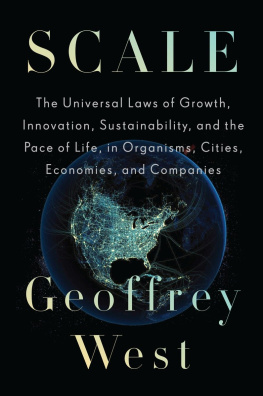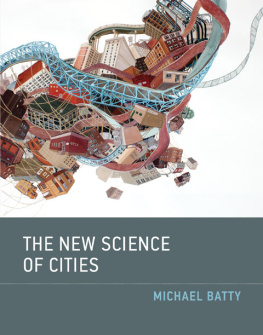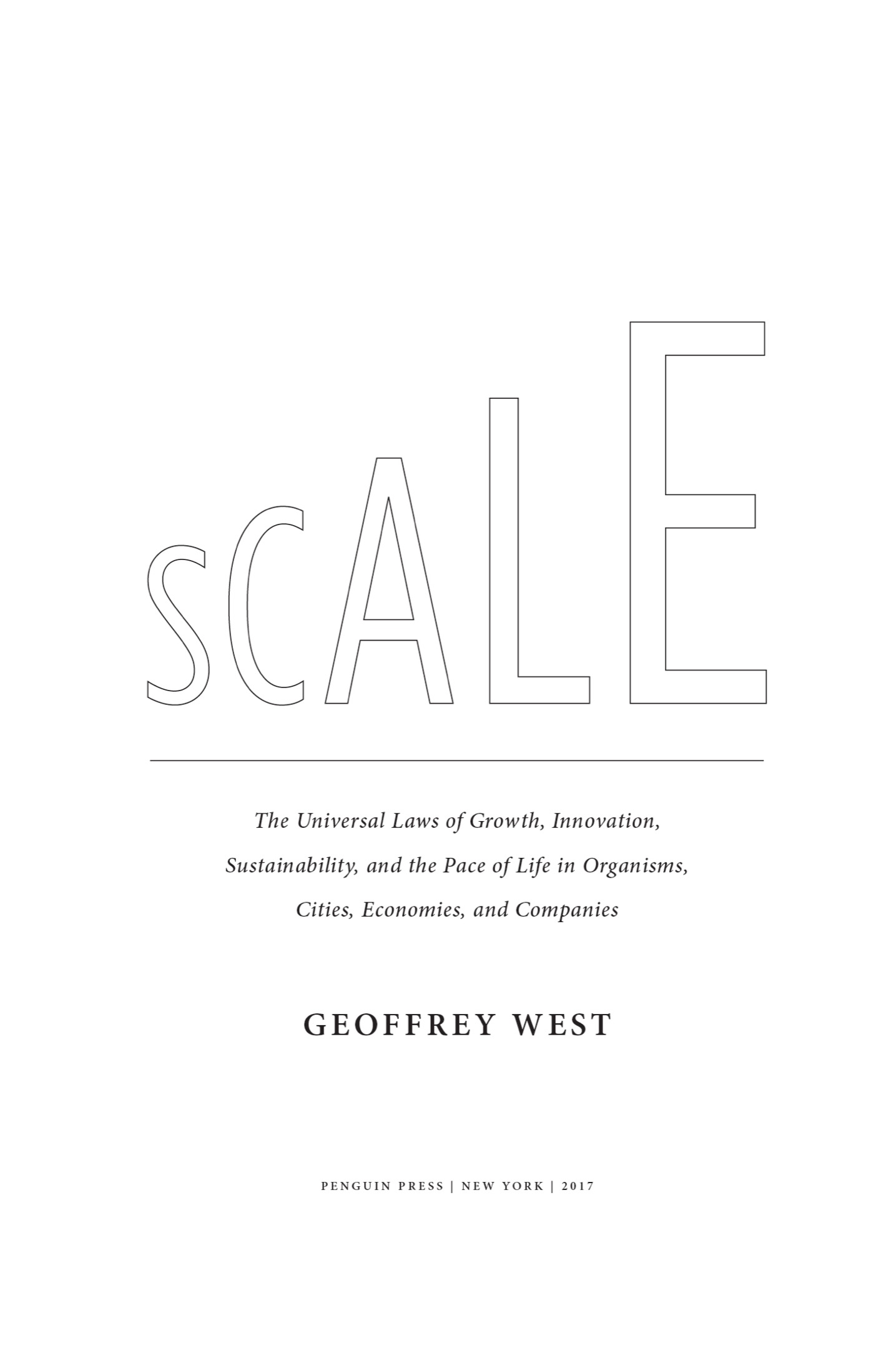Penguin supports copyright. Copyright fuels creativity, encourages diverse voices, promotes free speech, and creates a vibrant culture. Thank you for buying an authorized edition of this book and for complying with copyright laws by not reproducing, scanning, or distributing any part of it in any form without permission. You are supporting writers and allowing Penguin to continue to publish books for every reader.
Illustration credits appear .
Names: West, Geoffrey B., author.
Title: Scale : the universal laws of growth, innovation, sustainability, and the pace of life in organisms, cities, economies, and companies / Geoffrey West.
Description: New York : Penguin Press, [2017] | Includes bibliographical references and index.
Identifiers: LCCN 2016056756 (print) | LCCN 2017008356 (ebook) | ISBN 9781594205583 (hardcover) | ISBN 9781101621509 (ebook)
Subjects: LCSH: Scaling (Social sciences) | SciencePhilosophy. | Evolution (Biology) | EvolutionMolecular aspects. | Urban ecology (Sociology) | Social sciencesMethodology. | Sustainable development.
Classification: LCC H61.27 .W47 2017 (print) | LCC H61.27 (ebook) | DDC 303.44dc23
1
THE BIG PICTURE
1. INTRODUCTION, OVERVIEW, AND SUMMARY
Life is probably the most complex and diverse phenomenon in the universe, manifesting an extraordinary variety of forms, functions, and behaviors over an enormous range of scales. It is estimated for instance that there are more than eight million different species of organisms on our planet, Add to this extraordinary tapestry of biological life the astonishing complexity and diversity of social life that we humans have brought to the planet, especially in the guise of cities and all of the remarkable phenomena they encompass, ranging from commerce and architecture to the diversity of cultures and the innumerable hidden joys and sorrows of each of their citizens.
Compare any of this complex panoply with the extraordinary simplicity and order of the planets orbiting the sun, or the clockwork regularity of your watch or iPhone, and its natural to ponder whether there could possibly be any analogous hidden order underlying all of this complexity and diversity. Could there conceivably be a few simple rules that all organisms obey, indeed all complex systems, from plants and animals to cities and companies? Or is all of the drama being played out in the forests, savannahs, and cities across the globe arbitrary and capricious, just one haphazard event after another? Given the random nature of the evolutionary process that gave rise to all of this diversity, it might seem unlikely and counterintuitive that any regularity or systematic behavior would have emerged. After all, each of the multitude of organisms that constitute the biosphere, each of its subsystems, each organ, each cell type, and each genome has evolved by the process of natural selection in its own unique environmental niche following a unique historical path.
Now take a look at the panel of graphs in Figures 14. Each represents a well-known quantity that plays an important role in your life and each is plotted against size. The first graph is metabolic ratehow much food is needed each day to stay aliveplotted against the weight or mass of a series of animals. The second is the number of heartbeats in a lifetime, also plotted against the weight or mass of a series of animals. The third is the number of patents produced in a city plotted against its population. And the last is the net assets and income of publicly traded companies plotted against the number of their employees.
You dont have to be a mathematician, a scientist, or an expert in any of these areas to immediately see that although they represent some of the most extraordinarily complex and diverse processes we encounter in our lives, they reveal something surprisingly simple, systematic, and regular about each of them. Almost miraculously, the data have lined up in approximately straight lines rather than being arbitrarily distributed across each of these graphs, as might have been anticipated given the unique historical and geographical contingency of each animal, city, or company. Perhaps the most startling of these is Figure 2, which shows that the average number of heartbeats in the lifetime of any mammal is roughly the same, even though small ones like mice live for just a few years whereas big ones like whales can live for a hundred years or more.



Examples of scaling curves, which express how quantities scale with a change in size: (1) illustrates how metabolic rate scale with the number of their employees. Notice that these graphs cover a huge range of scales: for example, both weights of animals and numbers of employees vary by a factor of a million (from mice to elephants and from one-person businesses to the Walmarts and Exxons). In order to be able to put all of these animals, companies, and cities on these plots, the scale on each axis increases by factors of ten.
The examples shown in Figures 14 are just a tiny sampling of an enormous number of such scaling relationships that quantitatively describe how almost any measurable characteristic of animals, plants, ecosystems, cities, and companies scales with size. You will be seeing many more of them throughout this book. The existence of these remarkable regularities strongly suggests that there is a common conceptual framework underlying all of these very different highly complex phenomena and that the dynamics, growth, and organization of animals, plants, human social behavior, cities, and companies are, in fact, subject to similar generic laws.
This is the main focus of this book. I will explain the nature and origin of these systematic scaling laws, how they are all interrelated, and how they lead to a deep and broad understanding of many aspects of life and ultimately to the challenge of global sustainability. Taken together, these scaling laws provide us with a window onto underlying principles and concepts that can potentially lead to a quantitative predictive framework for addressing a host of critical questions across science and society.
This book is about a way of thinking, about asking big questions, and about suggesting big answers to some of those big questions. Its a book about how some of the major challenges and issues we are grappling with today, ranging from rapid urbanization, growth, and global sustainability to understanding cancer, metabolism, and the origins of aging and death, can be addressed in an integrated unifying conceptual framework. It is a book about the remarkably similar ways in which cities, companies, tumors, and our bodies work, and how each of them represents a variation on a general theme manifesting surprisingly systematic regularities and similarities in their organization, structure, and dynamics. A common property shared by all of them is that they are highly complex and composed of enormous numbers of individual constituents, whether molecules, cells, or people, connected, interacting, and evolving via networked structures over multiple spatial and temporal scales. Some of these networks are obvious and very physical, like our circulatory system or the roads in a city, but some are more conceptual or virtual, like social networks, ecosystems, and the Internet.
















